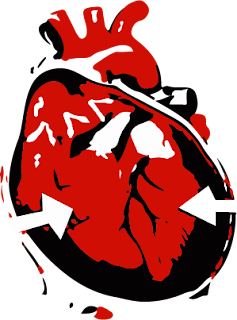Cardiac tamponade
 |
| Cardiac tamponade |
What is cardiac tamponade
Cardiac tamponade is a rare life-threatening complication in which there is accumulation of fluid, blood, clots, or gas in the pericardial space, the space between the myocardium and pericardium. Cardiac tamponade is the compression of the heart due to increased pericardial space pressure, which lead to insufficient blood ventricular filling and reduced cardiac output and reduced blood pressure. The accumulation of fluids in the pericardium, in quantity sufficient to cause significant obstruction of blood flow in the chamber, leading to cardiac tamponade, severe complications that can be fatal if it is not treated quickly.
Causes of cardiac tamponade
Causes of pericardial effusion and appearance of cardiac tamponade may be different, but the fluid in the pericardial space is most often affected because of pericarditis, chest trauma, aortic dissection, scarring, hypothyroidism, lung cancer, heart tumors, kidney failure, cancer of the blood cells, radiation therapy, wounds to the heart, systemic lupus erythematosus, uremia, and after a heart attack and open heart surgery. The amount of accumulated fluids in the pericardial space is not directly related to the appearance of cardiac tamponade. Rapid accumulation of small amounts of fluid can cause severe symptoms of cardiac tamponade because there is no time to stretch enough pericardium, causing a sudden pressure on the heart and blood flow difficulties. If in the pericardial space the accumulation of fluids is slowly, pericardium can adapt to large quantities of fluids even up to 2 liters without the occurrence of cardiac tamponade.
Most patients have a moderate amount of fluids in the pericardial space which does not lead to the occurrence of cardiac tamponade but cause difficulty in breathing. In the clinical picture of cardiac tamponade we can see a drop in blood pressure, increased systemic venous pressure and tachycardia with silent heart murmur.
Signs and symptoms of cardiac tamponade
The most common symptoms which appear in accumulation of fluids in the pericardial space that lead to cardiac tamponade are dyspnea and precordial pain caused by pericarditis, which are reduced in the upright position and leaning forward. In condition that leads to the development of cardiac tamponade we can see the following signs: pericarditis, oscillating changes in the voltage of ECG can be seen, nonspecific changes in the ST segment and T wave, and X-ray of the heart and lungs is showing symmetrically enlarged cardiac shadow.
Cardiac tamponade is an acute condition accompanied by paleness, sweating and anxiety, leads to hypotension and tachycardia, swollen veins on the neck are visible. Echocardiography reveal the presence of free fluid in the pericardial space and diastolic collapse of right heart cavities. The main symptom of cardiac tamponade is chest pain, shortness of breath and fatigue. Larger amount of fluids in the pericardial space cause severe dyspnea due to pressure on the lungs, difficulty swallowing due to pressure on the esophagus, cough due to pressure on the trachea and bronchus and the urge to vomit because of the pressure on the abdominal organs. The patient is pale, and his fingers, nose and ears are bruised, covered in sweat and his heart is working rapidly. In addition to standard tests of cardiac tamponade and tested for HIV is applied and tuberculosis. Cardiac catheterization with measurement of pressure in the heart chambers can help in diagnosis, but sometimes is a waste of time because cardiac tamponade is a life-threatening condition.
Treatment for cardiac tamponade
The treatment for cardiac tamponade comes down to the removal of fluids from the pericardial space and achieving normal blood flow. Fluid is removed with the help of special needle and blood flow is achieved by giving intravenous saline. It's also possible to remove part of the pericardium to remove fluid but it's rarely used.
During cardiac tamponade treatment, the oxygen is given to patient. After removal of the fluids, reason for occurrence of cardiac tamponade must be revealed. Cardiac tamponade treatment outcome is good, but it can come back, if cardiac tamponade is untreated then cardiac tamponade can cause death.